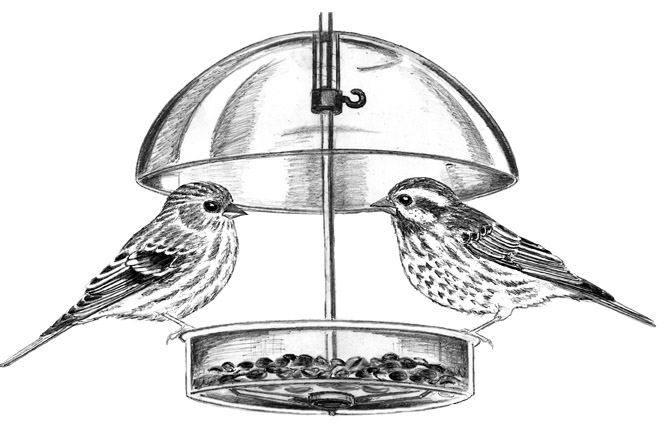
Dear Bird Folks,
Last year several Snowy Owls spent the winter here on the Cape. Do you think they’ll be back this winter?
– Adam, Dennis, MA
I don’t care, Adam,
Don’t get me wrong, I loved seeing those beautiful white birds as much as anybody. But for all of their beauty, Snowy Owls have one major flat: they don’t eat birdseed. The guy at the local camera store told me he sold all kinds of fancy photography equipment as a result of last year’s snowy craze. His cash registers were ringing all winter. Not mine. I think I sold an owl magnet or two, and that was it. I even invested in a vending machine that dispensed containers of live lemmings, hoping people would set up owl feeders in their backyards. Unfortunately, very few folks carried the 182 quarters needed to purchase the fresh lemmings from the machine. But that was last year. This year things may be going my way. Word on the street is that northern seedeaters are headed our way. I sure hope that’s true because I need the money. I still have fifty more payments to make on that stupid lemming vending machine.
Two weeks ago I was sitting at my desk, taking a refresher course on quantum physics (or checking my horoscope, I can’t remember which) when I noticed an odd bird on my feeder. It was eating with a flock of goldfinches and actually looked like a goldfinch, but not quite. I tried squinting, but that didn’t help, so I grabbed my binoculars. The mystery bird was a Pine Siskin. Pine Siskins are uncommon winter visitors to Cape Cod, but sometimes we see huge flocks of them, especially if there is a food shortage up north. And unlike the Snowy Owls, siskins eat vast amounts of seed. While I was excited to see this siskin, seeing only one of them didn’t really mean much. How much seed can one bird eat? Then a few days later a customer told me that she had dozens of these birds on her feeder. Yeah, baby. That’s what I’m talkin’ about. It could be a good Christmas after all.
With the exception of this one lady, many folks don’t notice siskins on their feeders. Why? As I mentioned above, siskins often associate with, and look very much like, their goldfinch cousins (in winter plumage). How can we tell the difference? You can try squinting, but I can say from experience that doesn’t always work. Siskins are small birds, with streaky brown bodies and just a hint of yellow in their wings. They have deeply-notched tails and their beaks are thinner and pointer than a typical finch, making them look like a cross between a warbler and Margaret Thatcher.
In addition to lots of siskin sightings this fall, we are also seeing more Purple Finches. This might not seem like big news to some folks, because even in the year 2014 plenty of people still think House Finches and Purple Finches are the same. They are not. (Look them up.) Purple Finches also aren’t common on Cape Cod and each year they are becoming rarer…or more rare. (I’m never sure which phrase is the more betterer to use.) Like the siskins, Purple Finches will also move south when food becomes scarce. But unlike siskins, which may descend upon our feeders in large flocks, Purple Finches usually arrive in much smaller numbers. Nevertheless, they can really devour birdseed, which is all that really matters.
In addition to their confusing looks, there’s another reason why Purple Finches and Pine Siskins are sometimes overlooked at feeders. When most folks drive around town they typically notice such things as the condition of the neighbors’ lawns or what political signs they’ve put out. Not me. I look at birdfeeders…of course. The first thing I notice is whether a particular feeder was purchased from me (and, if not, who will be coming off my Christmas card list). I also look to see if a feeder is filled, and ninety percent of the time it’s empty. (Boo!) The last thing I notice is the feeder’s location, which is often miles from the house. What’s up with that? Some people could have penguins eating from their feeders and they’d never know it. The only reason we feed birds is for our own entertainment. If the feeder is nearly out of sight, it’s kind of pointless. A feeder placed close to the house is easier to fill (especially in the winter) and if an odd bird does appear, it has far a better chance of being identified (with just a minimum amount of squinting).
I can’t say for sure if everyone will be seeing northern finches in their yards this winter, but there’s a good chance some people will. In Las Vegas experts try to predict the outcome of football games, horse races and even elections, but up in Canada they have a guy (Ron Pittawy) who annually forecasts the movement of winter finches. (Now there’s an exciting job). Ron thinks this will be a good winter to see not only Pine Siskins and Purple Finches, but redpolls as well. So, keep an eye on your thistle feeders and sunflower feeders. And for goodness sake, keep them filled or you’re coming off my Christmas card list, too.
As for Snowy Owls, Adam, so far I’ve only heard one report of a single bird being seen on Cape Cod, but it’s early, so perhaps more will follow. One way to increase your chances of seeing these owls is to fill your feeder with fresh, delicious lemmings. If you are clean out of lemmings at home, swing by my place and I’ll hook you up. Just remember to bring 182 quarters.